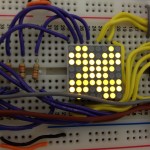Bonus-Pcomp
for the final project in Pcomp, I used 8×8 LED matrix and Real Time Clock device.
what I used for this project is RTC, LED Matrix, two shift registers, capacitor, magnets, LED, conductive tape.
I combined with Pcomp and soft circuit so user can play with each clock and make own shape with cubes.
Each clock shows different time of location and weather.











































